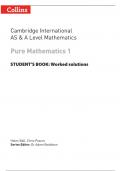Exam (elaborations)
Cambridge International AS & A Level Mathematics Pure Mathematics 1 Helen Ball, Chris Pearce
- Course
- Pure Mathematics 1
- Institution
- East Texas Baptist University
Please note: Full worked solutions are provided as an aid to learning, and represent one approach to answering the question. In some cases, alternative methods are shown for contrast. All sample answers have been written by the authors. Cambridge Assessment International Education bears no respo...
[Show more]



